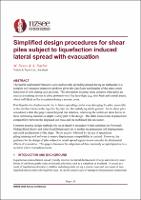| dc.contributor.author | Neves, Manuel | |
| dc.contributor.author | Naylor, Alexander | |
| dc.date.accessioned | 2020-06-18T13:41:58Z | |
| dc.date.available | 2020-06-18T13:41:58Z | |
| dc.date.issued | 2020-04-22 | |
| dc.identifier.uri | https://repo.nzsee.org.nz/xmlui/handle/nzsee/1699 | |
| dc.description.abstract | The lateral load transfer between a pile and laterally spreading ground during an earthquake is a complex soil-structure interaction problem given the significant nonlinearity of the stress-strain behaviour of soils during such an event. This interaction becomes more complex when piles are used as a retaining system in close proximity to a free face/slope (e.g. river beds and coastal areas), which will likely suffer evacuation during a seismic event.
Post-liquefaction displacements due to lateral spreading can be very damaging for piles, especially in the interface between the liquefied layer(s) and the underlying stable ground. As the shear piles considered within this paper extend beyond this interface, estimating the mobilised shear forces in these reinforcing elements at depth is a key part of the design. The latter must ensure displacement compatibility between the displaced soil mass and the mobilized pile resistance.
Common practice design methods rely on an iterative procedure which combines the Newmark Sliding Block theory and Limit Equilibrium analysis to predict the permanent soil displacements and yield accelerations of the slope. This is usually followed by the use of specialized piling/retaining wall software to ensure displacement compatibility is reached. However, the guidance for the design of piles subject to lateral spread appears to not consider the detrimental effects of evacuation. This papers discusses the adaptation of this commonly accepted practice to a scenario where evacuation occurs. | |
| dc.language.iso | en | |
| dc.publisher | New Zealand Society for Earthquake Engineering | |
| dc.relation.ispartofseries | 2020;36 | |
| dc.subject | Soil-structure interaction | |
| dc.title | Simplified design procedures for shear piles subject to liquefaction induced lateral spread with evacuation | |
| dc.type | Article | |

